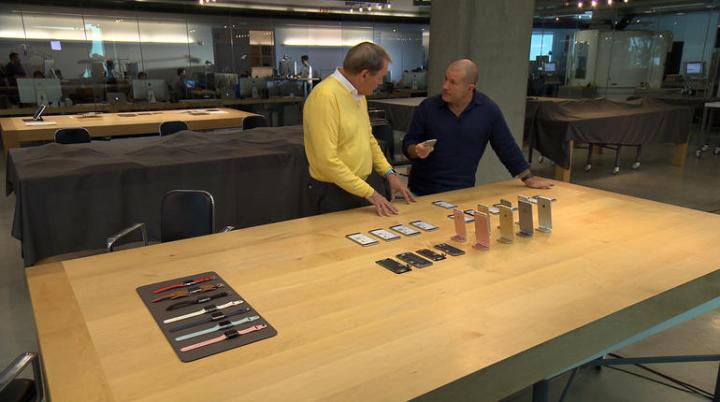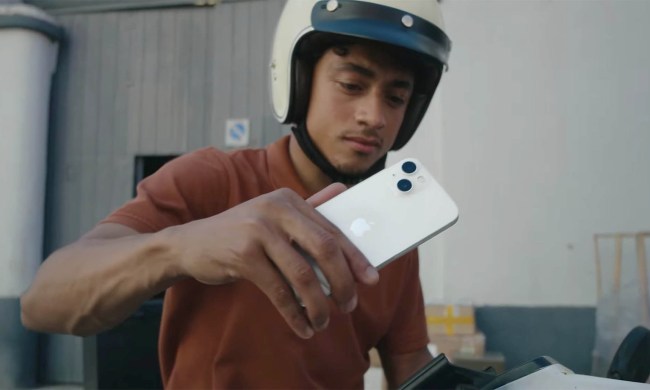
Missed the episode? Not to worry. We’ve summarized the highlights from last night. You can also watch the full segment on 60 Minutes’ website here.
‘This is still Steve’s company’
Asked about Steve Jobs’ legacy, Tim Cook asserted that the late CEO’s influence — and unrelenting vision — palpably endures. “This is Steve’s company. This is still Steve’s company,” he said. “It was born that way, it’s still that way … and so his spirit I think will always be the DNA of this company.”
He gave an example: every top-level executive at Apple including Senior VP Eddy Cue, software engineering head Craig Federighi, chief of retail and online stores Angela Ahrendts, marketing director Phil Schiller, participates in a mandatory 9 a.m. Monday morning meeting to discuss challenges with ongoing and upcoming projects.
“This is still Steve’s company. It was born that way, and so his spirit I think will always be the DNA of this company.”
Of any top-level creative at Apple, Rose said, chief design officer Jony Ive –- considered by many at Apple to be “the most important person at the company” –- seems to have taken Jobs’ relentless philosophy of perfection most closely to heart.
During an interview at Apple’s Palo Alto design lab, Ive revealed that Apple made ten different prototypes of the iPhone 6 and iPhone 6 Plus before settling on a single model. They had to “[feel] right” in an emotional kind of way, he told Rose, because different sizes and even textures can impact perception of a product. “[If] we manage to get [these things] right, you sort of sense that it’s an authentic, really thoughtfully conceived object,” he said.
Senior Director of Camera Hardware Graham Townsend told Rose that Apple devotes 800 engineers and specialists alone to the iPhone’s camera, and tests the camera’s performance with simulated lighting conditions from outdoor sunsets to dim interiors to “noonday light.” The delicate sensor contains 200 separate individual parts, some mere microns in width (the four wires which hold that autofocus motor in place are each 40 microns thick – less than the width of a human hair), and completes “24 billion operations” to take a single image.
Apple’s design studio is “quiet and looks a lot like an Apple store”
On a guided tour of Apple’s design lab, Rose remarked that the space had more than a passing resemblance to Apple’s brick-and-mortar stores. Staff work at thick, patterned wooden tables of Ive’s design. Work appeared very much in progress: black fabric hid the department’s more sensitive prototypes from view.
Ive said that the design team, a group of 22 core engineers, can rapidly prototype product designs with the aid of computer design software and a high-precision milling device that fashions blocks of aluminum. Craftsman polish the resulting model by hand.
Apple purposefully competes with itself
Apple’s a bit counter-intuitive when it comes to product cannibalism, marketing chief Phil Schiller told Rose, in that it’s encouraged. “You need each of [our] products to try to fight for their space, their time with you,” he said. “[It’s] almost by design. “The iPhone has to become so great that you don’t know why you want the iPad. The iPad has to be so great that you don’t know why you want a notebook. The notebook has to be so great, you don’t know you want a desktop. Each one’s job is to compete with the other ones.”
On the Apple Watch
Rose asked Cook pointedly about the Apple Watch. Asked whether its perceived slow uptake had anything to do with flaws within the company’s control, said Cook: “I think all products are going to [need] improvement and the Watch is no exception to that. Ive’s team is constantly iterating on Watch designs and Watch accessories,” Cook said, on any given day testing hundreds of band types, materials, and colors. “When we launch a product, we’re already working on the next one. And possibly the next one, next one. [We] always see things we can do.”
Encryption just makes sense
Defending Apple’s decision to implement encryption by default on many of its devices, Cook said there was no more effective way to protect the sort of sensitive information that inhabits most people’s smartphones, laptops, and tablets. “[On] your iPhone there’s health information, there’s financial information. There intimate conversations with family, or your co-workers. There’s probably business secrets and you should have the ability to protect it,” he said. “The only way we know how to do that is to encrypt it.”
Furthermore, Cook said, any sort of “back door” or method around that security is ripe for exploitation. “If there’s a way to get in, then somebody will find the way in,” he said. “The reality is that if you put a back door in, that back door’s for everybody, for good guys and bad guys.” He acknowledged that the absence of such a back door inhibits law enforcement to an extent (Apple can’t retrieve encrypted iMessages, for example), but that the company had to strike a balance between privacy and security.
Cook’s not a fan of the U.S. tax code and Chinese laborers have specialized skills
On the subject of Apple’s nearly $200 billion in untaxed offshore holdings, Cook was vehement that the United State’s tax code made transferring any of the assets untenable. (“This is a tax code … that was made for the industrial age, not the digital age,” he told Rose.) And he called accusations that the company avoided taxes on $74 billion in overseas revenues “total political crap” — under the current law, it’d cost Apple 40 percent of that total to move it stateside — and he emphasized that the company, on the whole, “[pays] more taxes in this country than anyone,” he said.
Asked about the reasons Apple chose China rather than the United States to assemble its products Cook said the reasons were less financial than practical. “China put an enormous focus on manufacturing,” Cook says. “In what we would call, you and I would call vocational kind of skills. The U.S., over time, began to stop having as many vocational kind of skills.” Schooling’s the biggest factor. “It’s because of a focus on [those skills] it’s a focus of their educational system,” he said, “and so that is the reality.”
Apple’s new spaceship campus looks amazing
The Apple campus tour ended with a look at Apple’s new circular, spaceship-shaped headquarters. The project, which Cook said measures wider than the Pentagon and will house more than 13,000 employees, is estimated to cost $5 billion. A construction crew of 3,500 is assembling the structure, which includes 3,000 sheets of curved glass imported from Germany.
One focus of the new campus is sustainability. Its center area will contain fruit and vegetable gardens from which the cafeteria will source, and a natural ventilation system on the roof will prevent the need for heating and air-conditioning most of the year. And thanks to a system of solar panels, it’s entirely independent of the electrical grid.





